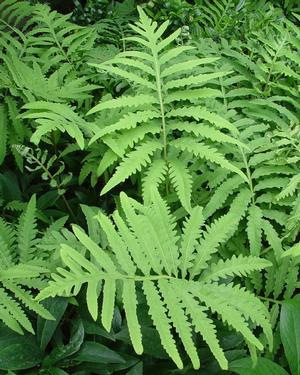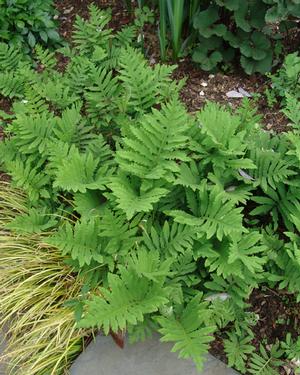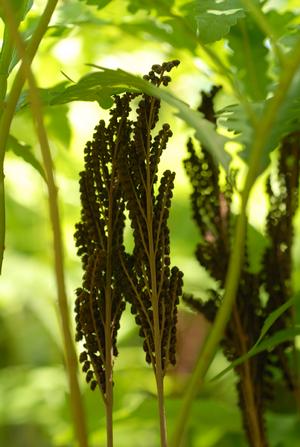Onoclea sensibilis
Common: sensitive fernOnoclea sensibilis LP32 - 32 per flat
- Height: 1'-2'
- Spread: 12"-18"
- Spacing: 12"
- Hardiness Zone(s): 2-10


Onoclea sensibilis LP32 - 32 per flat



Prefers moist, rich, well-drained, neutral to acidic soils in full to partial shade. Needs consistent moisture. Spreads freely by rhizomes especially in moist, loose soils. Propagate by division every few years in the spring. Best used as a groundcover in the naturalized, shaded or woodland garden, as a border or edge.
Onoclea sensibilis, or sensitive fern, tackles the difficult location of moist shade and is an effective groundcover. Growing anywhere from a few inches tall to 3’, sensitive fern has deeply pinnatifid infertile leaves in a bright green with fertile fronds covered in spores and standing erect in the late summer. Fronds emerge directly from the rootstock with rootstock growing freely. Commonly found in the Mid-Atlantic along roadsides and in wet meadows, Onoclea sensibilis is a very low maintenance deciduous fern whose bold fronds are great contrast with more delicate foliage such as with Carex or Porteranthus. Don’t let the common name fool you—sensitive fern is a tough plant. While it doesn’t shirk from touch like sensitive plant does, it does blacken even in light frost which signals its dormancy. Wait for it to reemerge in spring to be delighted by its presence again.
Sensitive fern grows as far north as Nova Scotia and as far south as Florida and west to Wyoming and Colorado. Onoclea sensibilis prefers moist, rich well-drained soils in full to partial shade. It can tolerate full sun but requires consistent soil moisture. Typically found in meadows and fields, shores of rivers or lakes, swamps, and wetland margins. The fern is usually found in natural areas of medium to high quality. It tolerates heavy clay soil, deep shade, and rabbits. While wonderful in rain gardens, sensitive ferns do not like to sit in stagnant water or in ‘sour’ clay. The fern needs oxygen at its roots.
Perfect for a naturalized setting such as a woodland garden, along a border, or in a shady rain garden, sensitive fern provides habitat for wetland creatures such as salamanders and frogs. It supports a few insect species but overall, does not have pollinator value. An ancient fern, fossils of its fronds have been found alongside dinosaurs. Few evolutionary changes occurred over millions of years with the sensitive fern’s closest living relative in this region being Matteuccia struthiopteris. This fern is found in parts of East Asia, further evidence of its ancient heritage.